Analysis of Work Health & Safety on the Construction Site Report
VerifiedAdded on 2022/07/27
|8
|1607
|44
Report
AI Summary
This report provides a detailed analysis of work health and safety (WHS) on construction sites, focusing on the identification, assessment, and control of risks. It begins with an executive summary and objective statement, outlining the need for improved safety measures in the hazardous construction industry. The report delves into the background of WHS issues, highlighting the high incidence of injuries and illnesses, and the importance of risk management. It then explores risk assessment and control, emphasizing their advantages and disadvantages, and implications for the industry. The findings section examines occupational health and safety (OH&S) policies, their benefits, drawbacks, and impact on the construction sector. The report concludes by reiterating the critical role of WHS and the necessity for proactive measures to ensure a safe working environment. References are included to support the findings and recommendations. The report is based on the assignment brief provided to the student, and the structure and content follow the guidelines provided by the university.
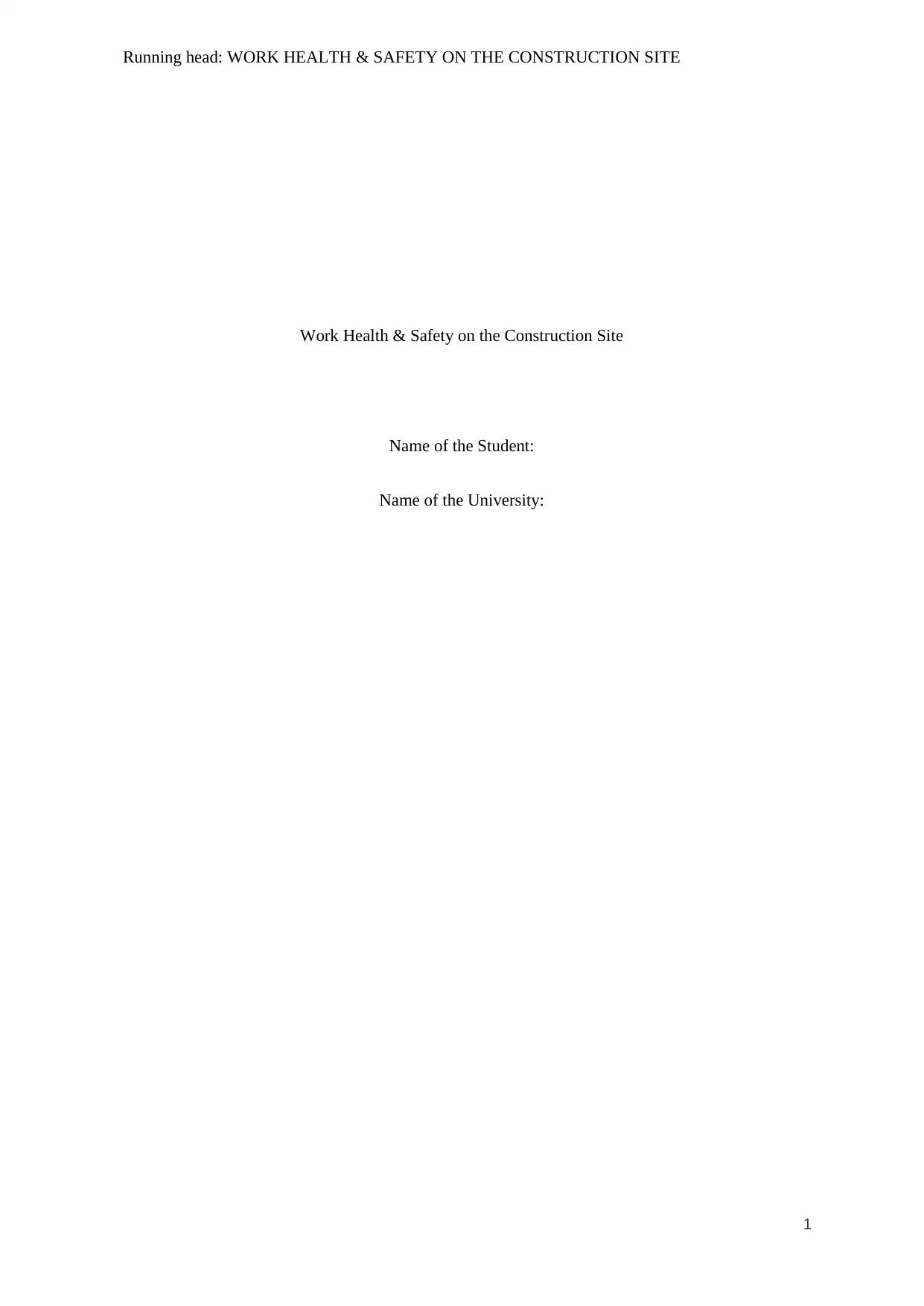
Running head: WORK HEALTH & SAFETY ON THE CONSTRUCTION SITE
Work Health & Safety on the Construction Site
Name of the Student:
Name of the University:
1
Work Health & Safety on the Construction Site
Name of the Student:
Name of the University:
1
Paraphrase This Document
Need a fresh take? Get an instant paraphrase of this document with our AI Paraphraser
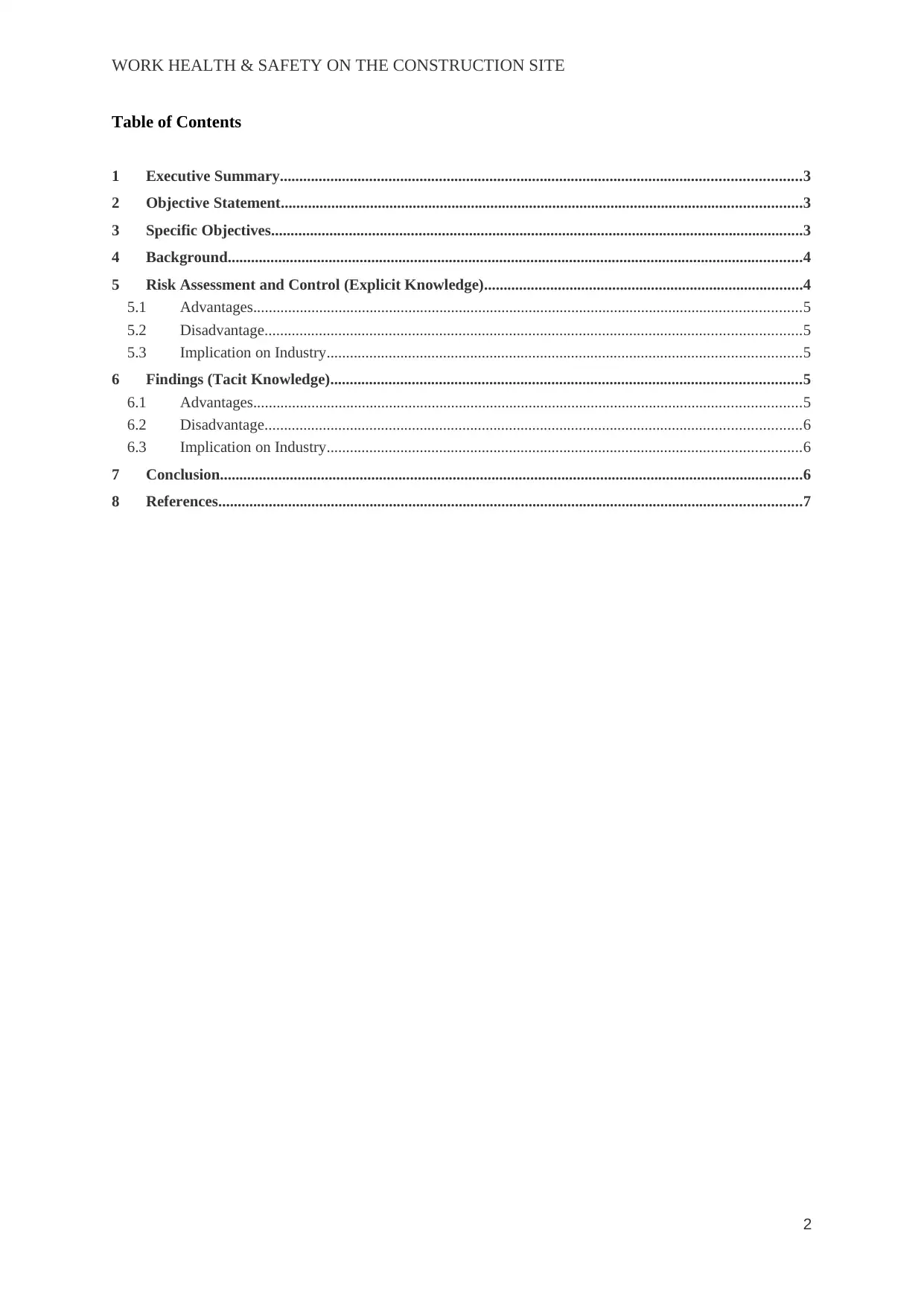
WORK HEALTH & SAFETY ON THE CONSTRUCTION SITE
Table of Contents
1 Executive Summary......................................................................................................................................3
2 Objective Statement......................................................................................................................................3
3 Specific Objectives.........................................................................................................................................3
4 Background....................................................................................................................................................4
5 Risk Assessment and Control (Explicit Knowledge)..................................................................................4
5.1 Advantages.............................................................................................................................................5
5.2 Disadvantage..........................................................................................................................................5
5.3 Implication on Industry..........................................................................................................................5
6 Findings (Tacit Knowledge).........................................................................................................................5
6.1 Advantages.............................................................................................................................................5
6.2 Disadvantage..........................................................................................................................................6
6.3 Implication on Industry..........................................................................................................................6
7 Conclusion......................................................................................................................................................6
8 References......................................................................................................................................................7
2
Table of Contents
1 Executive Summary......................................................................................................................................3
2 Objective Statement......................................................................................................................................3
3 Specific Objectives.........................................................................................................................................3
4 Background....................................................................................................................................................4
5 Risk Assessment and Control (Explicit Knowledge)..................................................................................4
5.1 Advantages.............................................................................................................................................5
5.2 Disadvantage..........................................................................................................................................5
5.3 Implication on Industry..........................................................................................................................5
6 Findings (Tacit Knowledge).........................................................................................................................5
6.1 Advantages.............................................................................................................................................5
6.2 Disadvantage..........................................................................................................................................6
6.3 Implication on Industry..........................................................................................................................6
7 Conclusion......................................................................................................................................................6
8 References......................................................................................................................................................7
2
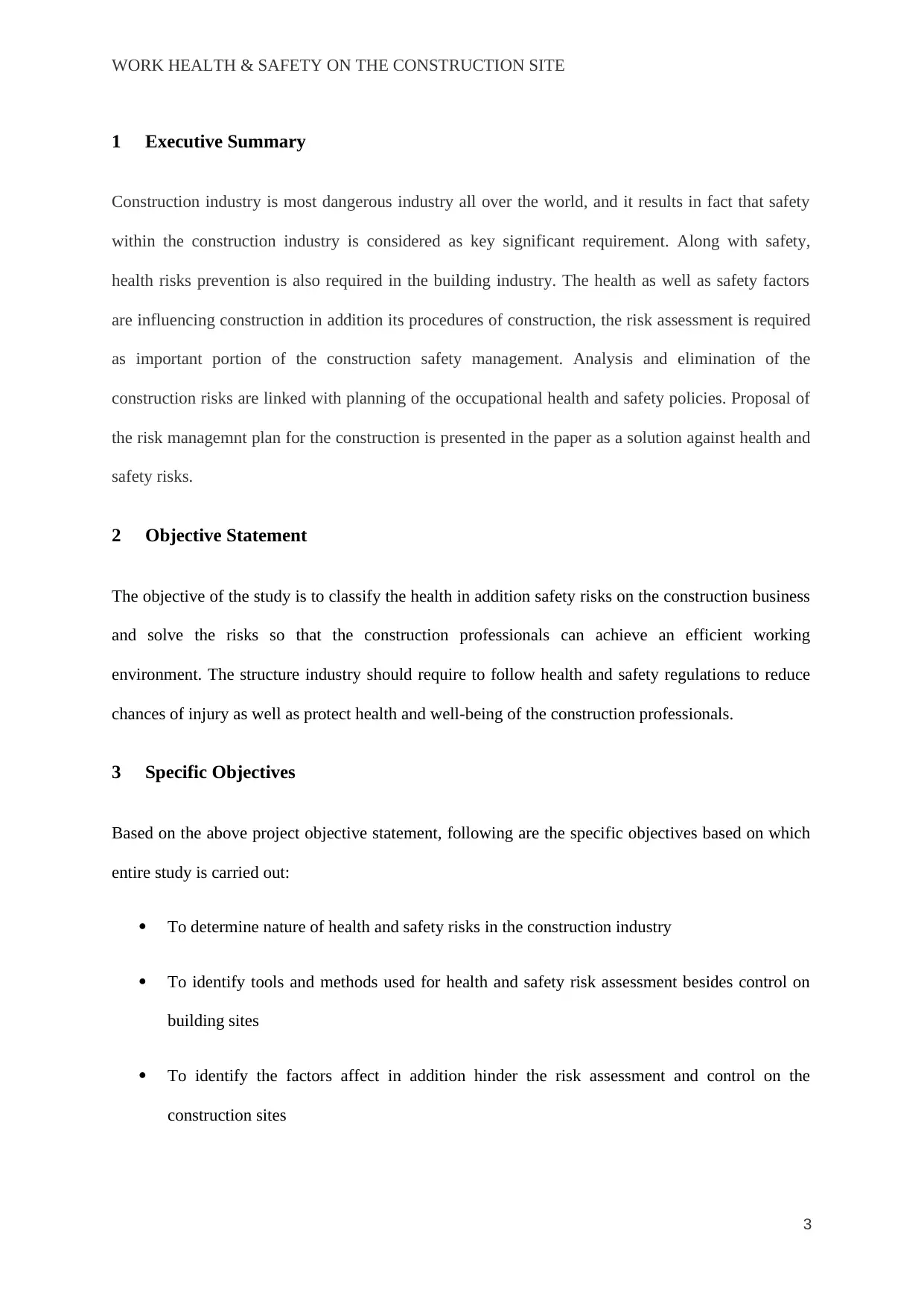
WORK HEALTH & SAFETY ON THE CONSTRUCTION SITE
1 Executive Summary
Construction industry is most dangerous industry all over the world, and it results in fact that safety
within the construction industry is considered as key significant requirement. Along with safety,
health risks prevention is also required in the building industry. The health as well as safety factors
are influencing construction in addition its procedures of construction, the risk assessment is required
as important portion of the construction safety management. Analysis and elimination of the
construction risks are linked with planning of the occupational health and safety policies. Proposal of
the risk managemnt plan for the construction is presented in the paper as a solution against health and
safety risks.
2 Objective Statement
The objective of the study is to classify the health in addition safety risks on the construction business
and solve the risks so that the construction professionals can achieve an efficient working
environment. The structure industry should require to follow health and safety regulations to reduce
chances of injury as well as protect health and well-being of the construction professionals.
3 Specific Objectives
Based on the above project objective statement, following are the specific objectives based on which
entire study is carried out:
To determine nature of health and safety risks in the construction industry
To identify tools and methods used for health and safety risk assessment besides control on
building sites
To identify the factors affect in addition hinder the risk assessment and control on the
construction sites
3
1 Executive Summary
Construction industry is most dangerous industry all over the world, and it results in fact that safety
within the construction industry is considered as key significant requirement. Along with safety,
health risks prevention is also required in the building industry. The health as well as safety factors
are influencing construction in addition its procedures of construction, the risk assessment is required
as important portion of the construction safety management. Analysis and elimination of the
construction risks are linked with planning of the occupational health and safety policies. Proposal of
the risk managemnt plan for the construction is presented in the paper as a solution against health and
safety risks.
2 Objective Statement
The objective of the study is to classify the health in addition safety risks on the construction business
and solve the risks so that the construction professionals can achieve an efficient working
environment. The structure industry should require to follow health and safety regulations to reduce
chances of injury as well as protect health and well-being of the construction professionals.
3 Specific Objectives
Based on the above project objective statement, following are the specific objectives based on which
entire study is carried out:
To determine nature of health and safety risks in the construction industry
To identify tools and methods used for health and safety risk assessment besides control on
building sites
To identify the factors affect in addition hinder the risk assessment and control on the
construction sites
3
⊘ This is a preview!⊘
Do you want full access?
Subscribe today to unlock all pages.

Trusted by 1+ million students worldwide
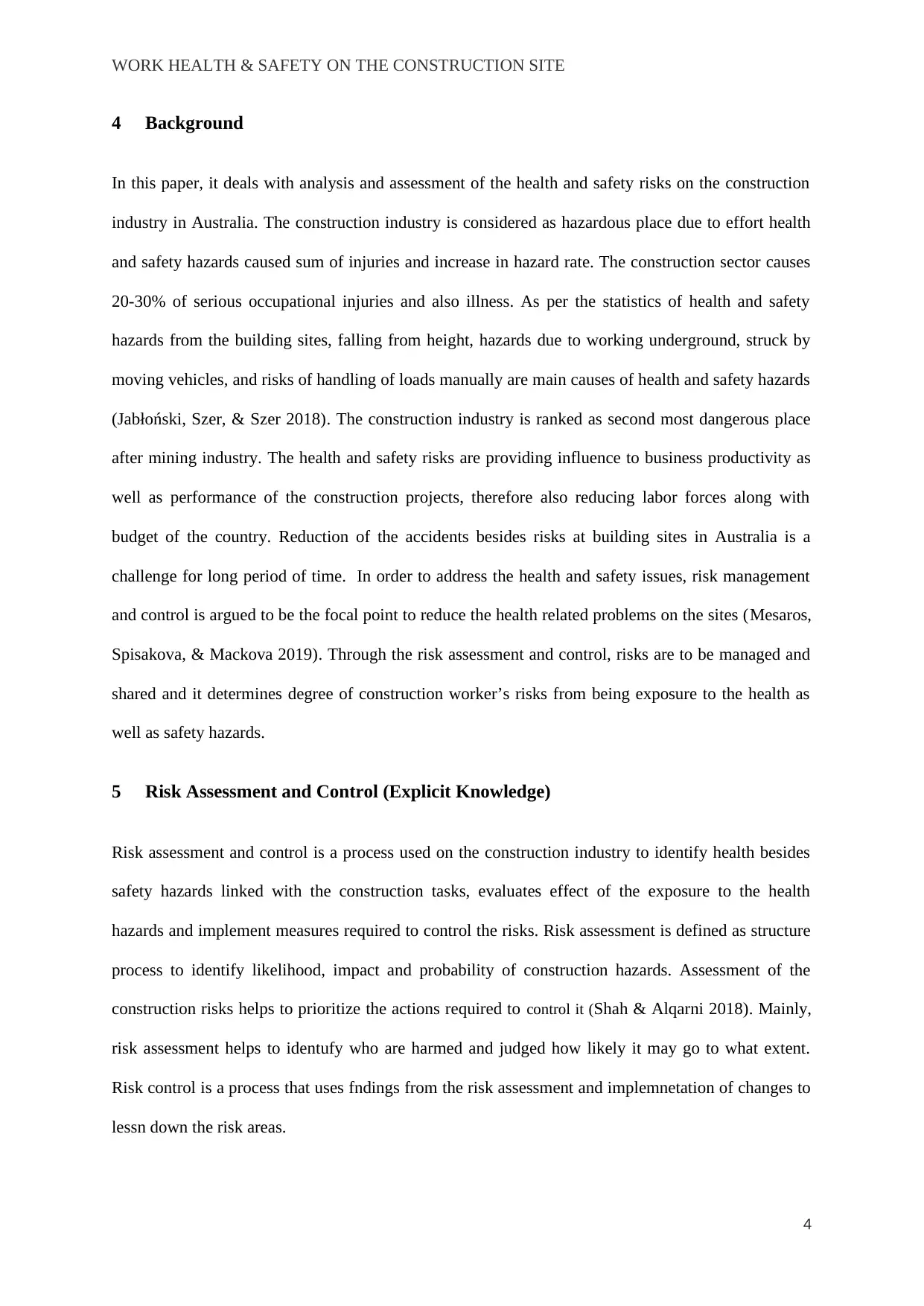
WORK HEALTH & SAFETY ON THE CONSTRUCTION SITE
4 Background
In this paper, it deals with analysis and assessment of the health and safety risks on the construction
industry in Australia. The construction industry is considered as hazardous place due to effort health
and safety hazards caused sum of injuries and increase in hazard rate. The construction sector causes
20-30% of serious occupational injuries and also illness. As per the statistics of health and safety
hazards from the building sites, falling from height, hazards due to working underground, struck by
moving vehicles, and risks of handling of loads manually are main causes of health and safety hazards
(Jabłoński, Szer, & Szer 2018). The construction industry is ranked as second most dangerous place
after mining industry. The health and safety risks are providing influence to business productivity as
well as performance of the construction projects, therefore also reducing labor forces along with
budget of the country. Reduction of the accidents besides risks at building sites in Australia is a
challenge for long period of time. In order to address the health and safety issues, risk management
and control is argued to be the focal point to reduce the health related problems on the sites (Mesaros,
Spisakova, & Mackova 2019). Through the risk assessment and control, risks are to be managed and
shared and it determines degree of construction worker’s risks from being exposure to the health as
well as safety hazards.
5 Risk Assessment and Control (Explicit Knowledge)
Risk assessment and control is a process used on the construction industry to identify health besides
safety hazards linked with the construction tasks, evaluates effect of the exposure to the health
hazards and implement measures required to control the risks. Risk assessment is defined as structure
process to identify likelihood, impact and probability of construction hazards. Assessment of the
construction risks helps to prioritize the actions required to control it (Shah & Alqarni 2018). Mainly,
risk assessment helps to identufy who are harmed and judged how likely it may go to what extent.
Risk control is a process that uses fndings from the risk assessment and implemnetation of changes to
lessn down the risk areas.
4
4 Background
In this paper, it deals with analysis and assessment of the health and safety risks on the construction
industry in Australia. The construction industry is considered as hazardous place due to effort health
and safety hazards caused sum of injuries and increase in hazard rate. The construction sector causes
20-30% of serious occupational injuries and also illness. As per the statistics of health and safety
hazards from the building sites, falling from height, hazards due to working underground, struck by
moving vehicles, and risks of handling of loads manually are main causes of health and safety hazards
(Jabłoński, Szer, & Szer 2018). The construction industry is ranked as second most dangerous place
after mining industry. The health and safety risks are providing influence to business productivity as
well as performance of the construction projects, therefore also reducing labor forces along with
budget of the country. Reduction of the accidents besides risks at building sites in Australia is a
challenge for long period of time. In order to address the health and safety issues, risk management
and control is argued to be the focal point to reduce the health related problems on the sites (Mesaros,
Spisakova, & Mackova 2019). Through the risk assessment and control, risks are to be managed and
shared and it determines degree of construction worker’s risks from being exposure to the health as
well as safety hazards.
5 Risk Assessment and Control (Explicit Knowledge)
Risk assessment and control is a process used on the construction industry to identify health besides
safety hazards linked with the construction tasks, evaluates effect of the exposure to the health
hazards and implement measures required to control the risks. Risk assessment is defined as structure
process to identify likelihood, impact and probability of construction hazards. Assessment of the
construction risks helps to prioritize the actions required to control it (Shah & Alqarni 2018). Mainly,
risk assessment helps to identufy who are harmed and judged how likely it may go to what extent.
Risk control is a process that uses fndings from the risk assessment and implemnetation of changes to
lessn down the risk areas.
4
Paraphrase This Document
Need a fresh take? Get an instant paraphrase of this document with our AI Paraphraser
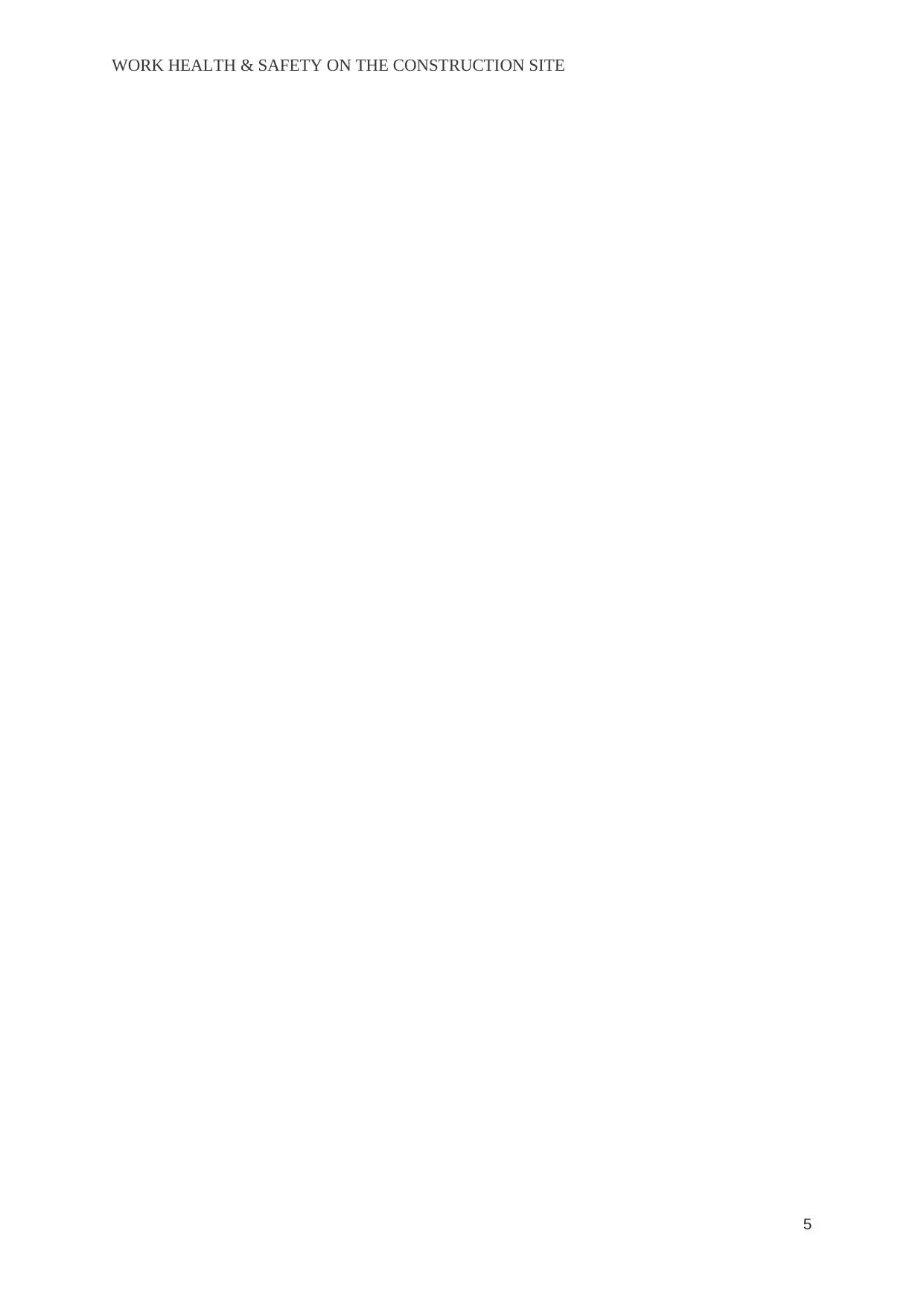
WORK HEALTH & SAFETY ON THE CONSTRUCTION SITE
5
5

WORK HEALTH & SAFETY ON THE CONSTRUCTION SITE
5.1 Advantages
Risk Assessment helps to communicate the health as well as safety policy with the construction
professionals and workers (Sutrisna & Goulding 2019). It is required part of the business planning as
well as construction organizations to provide safe working environment for the workers.
5.2 Disadvantage
Limitation of the risk assessment and control technique is included lack of the comprehensive health
and safety data, insufficient time and training to perform the investigation (Gao, Gonzalez, & Yiu
2019). The legal constaints command to manage the events provide impact on the deadlines of the
project plan.
5.3 Implication on Industry
Effective risk management plan imporves safety and health area of the workplace. The solution will
affect the industry by implementing workplace procedures regarding health and safety of all
workforces so there is prevention of hazards (Will 2018). The solution will benefit workers as
workplace safety is enhanced. The disadvantage of this solution is that there is a change in workplace
policies, therefore workers should keep informed about new policies and apply within their
workplace.
6 Findings (Tacit Knowledge)
OH&S plays a significant part of the risk management. Occupational health and safety (OH&S) is
identified as a way to protect from the health in addition safety risks. It is one of the solutuon for the
risk assessment solutions, through which it seeks to protect the construction workers by ensuring that
policies are strictly implemented in the business organization (Lei et al. 2018). This OH&S policies is
set out the responsbilities of the working parties and right of the construction workers. It provides
with implementation of laws where the workplace policies are not being adhered to.
6
5.1 Advantages
Risk Assessment helps to communicate the health as well as safety policy with the construction
professionals and workers (Sutrisna & Goulding 2019). It is required part of the business planning as
well as construction organizations to provide safe working environment for the workers.
5.2 Disadvantage
Limitation of the risk assessment and control technique is included lack of the comprehensive health
and safety data, insufficient time and training to perform the investigation (Gao, Gonzalez, & Yiu
2019). The legal constaints command to manage the events provide impact on the deadlines of the
project plan.
5.3 Implication on Industry
Effective risk management plan imporves safety and health area of the workplace. The solution will
affect the industry by implementing workplace procedures regarding health and safety of all
workforces so there is prevention of hazards (Will 2018). The solution will benefit workers as
workplace safety is enhanced. The disadvantage of this solution is that there is a change in workplace
policies, therefore workers should keep informed about new policies and apply within their
workplace.
6 Findings (Tacit Knowledge)
OH&S plays a significant part of the risk management. Occupational health and safety (OH&S) is
identified as a way to protect from the health in addition safety risks. It is one of the solutuon for the
risk assessment solutions, through which it seeks to protect the construction workers by ensuring that
policies are strictly implemented in the business organization (Lei et al. 2018). This OH&S policies is
set out the responsbilities of the working parties and right of the construction workers. It provides
with implementation of laws where the workplace policies are not being adhered to.
6
⊘ This is a preview!⊘
Do you want full access?
Subscribe today to unlock all pages.

Trusted by 1+ million students worldwide
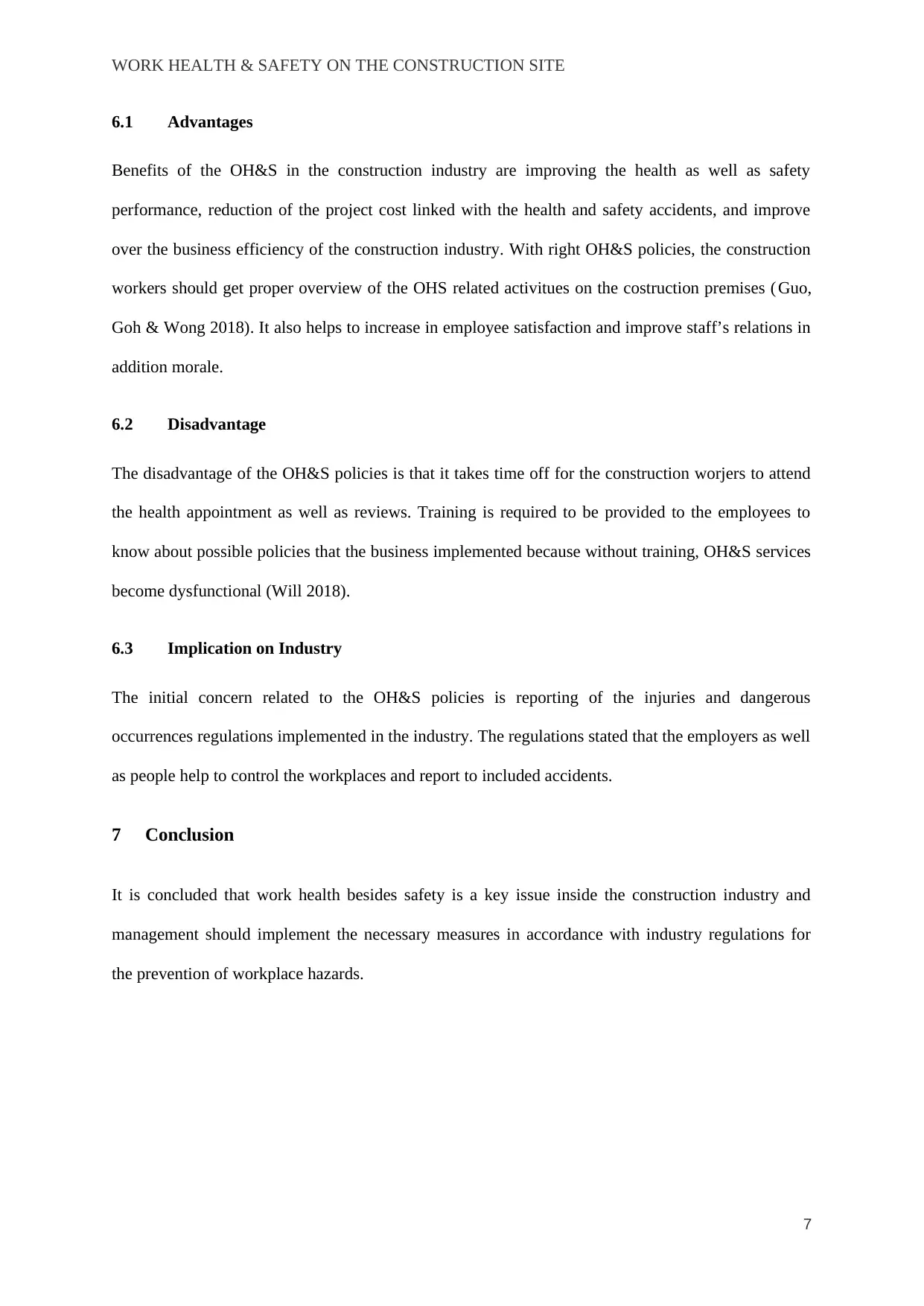
WORK HEALTH & SAFETY ON THE CONSTRUCTION SITE
6.1 Advantages
Benefits of the OH&S in the construction industry are improving the health as well as safety
performance, reduction of the project cost linked with the health and safety accidents, and improve
over the business efficiency of the construction industry. With right OH&S policies, the construction
workers should get proper overview of the OHS related activitues on the costruction premises ( Guo,
Goh & Wong 2018). It also helps to increase in employee satisfaction and improve staff’s relations in
addition morale.
6.2 Disadvantage
The disadvantage of the OH&S policies is that it takes time off for the construction worjers to attend
the health appointment as well as reviews. Training is required to be provided to the employees to
know about possible policies that the business implemented because without training, OH&S services
become dysfunctional (Will 2018).
6.3 Implication on Industry
The initial concern related to the OH&S policies is reporting of the injuries and dangerous
occurrences regulations implemented in the industry. The regulations stated that the employers as well
as people help to control the workplaces and report to included accidents.
7 Conclusion
It is concluded that work health besides safety is a key issue inside the construction industry and
management should implement the necessary measures in accordance with industry regulations for
the prevention of workplace hazards.
7
6.1 Advantages
Benefits of the OH&S in the construction industry are improving the health as well as safety
performance, reduction of the project cost linked with the health and safety accidents, and improve
over the business efficiency of the construction industry. With right OH&S policies, the construction
workers should get proper overview of the OHS related activitues on the costruction premises ( Guo,
Goh & Wong 2018). It also helps to increase in employee satisfaction and improve staff’s relations in
addition morale.
6.2 Disadvantage
The disadvantage of the OH&S policies is that it takes time off for the construction worjers to attend
the health appointment as well as reviews. Training is required to be provided to the employees to
know about possible policies that the business implemented because without training, OH&S services
become dysfunctional (Will 2018).
6.3 Implication on Industry
The initial concern related to the OH&S policies is reporting of the injuries and dangerous
occurrences regulations implemented in the industry. The regulations stated that the employers as well
as people help to control the workplaces and report to included accidents.
7 Conclusion
It is concluded that work health besides safety is a key issue inside the construction industry and
management should implement the necessary measures in accordance with industry regulations for
the prevention of workplace hazards.
7
Paraphrase This Document
Need a fresh take? Get an instant paraphrase of this document with our AI Paraphraser
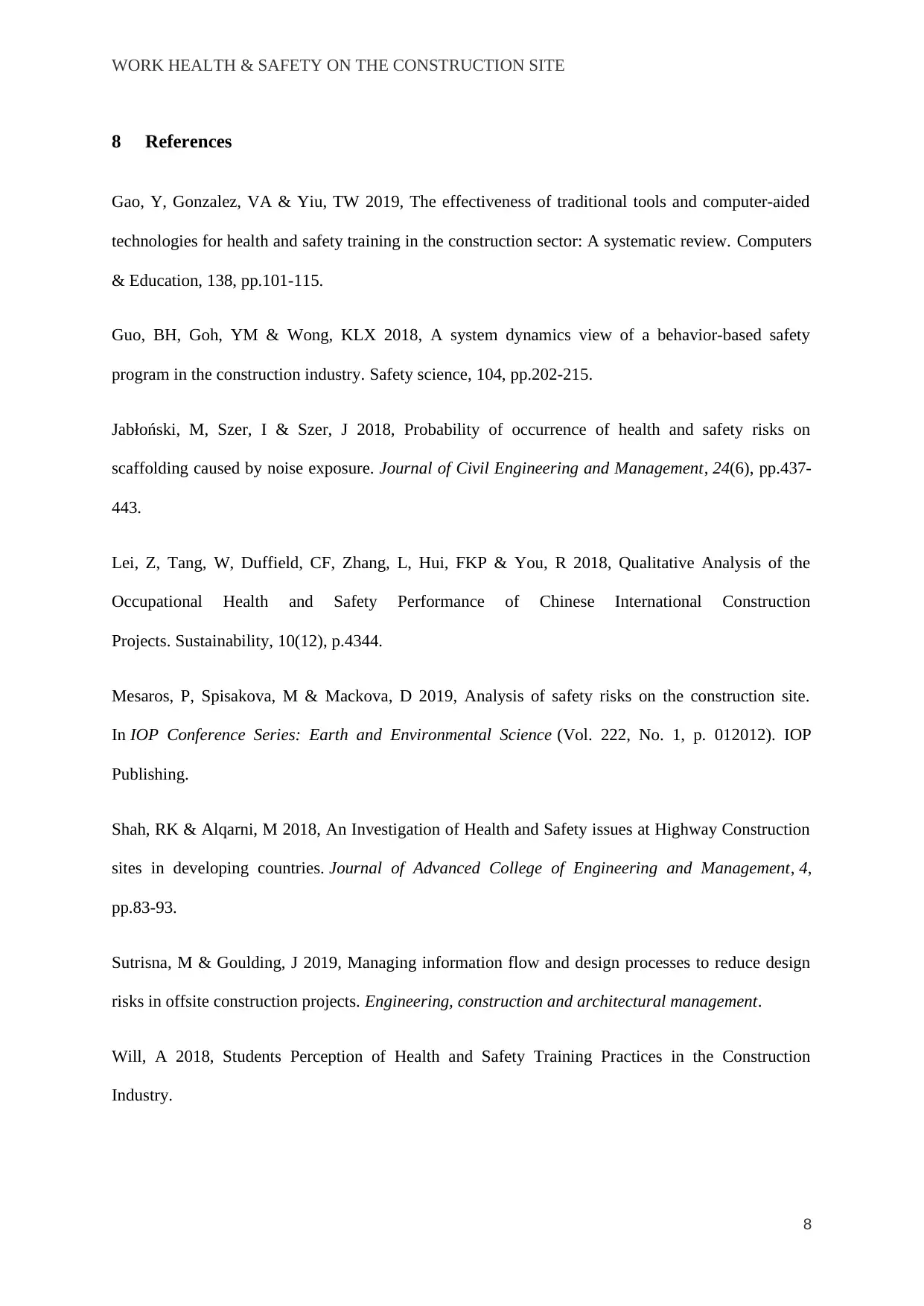
WORK HEALTH & SAFETY ON THE CONSTRUCTION SITE
8 References
Gao, Y, Gonzalez, VA & Yiu, TW 2019, The effectiveness of traditional tools and computer-aided
technologies for health and safety training in the construction sector: A systematic review. Computers
& Education, 138, pp.101-115.
Guo, BH, Goh, YM & Wong, KLX 2018, A system dynamics view of a behavior-based safety
program in the construction industry. Safety science, 104, pp.202-215.
Jabłoński, M, Szer, I & Szer, J 2018, Probability of occurrence of health and safety risks on
scaffolding caused by noise exposure. Journal of Civil Engineering and Management, 24(6), pp.437-
443.
Lei, Z, Tang, W, Duffield, CF, Zhang, L, Hui, FKP & You, R 2018, Qualitative Analysis of the
Occupational Health and Safety Performance of Chinese International Construction
Projects. Sustainability, 10(12), p.4344.
Mesaros, P, Spisakova, M & Mackova, D 2019, Analysis of safety risks on the construction site.
In IOP Conference Series: Earth and Environmental Science (Vol. 222, No. 1, p. 012012). IOP
Publishing.
Shah, RK & Alqarni, M 2018, An Investigation of Health and Safety issues at Highway Construction
sites in developing countries. Journal of Advanced College of Engineering and Management, 4,
pp.83-93.
Sutrisna, M & Goulding, J 2019, Managing information flow and design processes to reduce design
risks in offsite construction projects. Engineering, construction and architectural management.
Will, A 2018, Students Perception of Health and Safety Training Practices in the Construction
Industry.
8
8 References
Gao, Y, Gonzalez, VA & Yiu, TW 2019, The effectiveness of traditional tools and computer-aided
technologies for health and safety training in the construction sector: A systematic review. Computers
& Education, 138, pp.101-115.
Guo, BH, Goh, YM & Wong, KLX 2018, A system dynamics view of a behavior-based safety
program in the construction industry. Safety science, 104, pp.202-215.
Jabłoński, M, Szer, I & Szer, J 2018, Probability of occurrence of health and safety risks on
scaffolding caused by noise exposure. Journal of Civil Engineering and Management, 24(6), pp.437-
443.
Lei, Z, Tang, W, Duffield, CF, Zhang, L, Hui, FKP & You, R 2018, Qualitative Analysis of the
Occupational Health and Safety Performance of Chinese International Construction
Projects. Sustainability, 10(12), p.4344.
Mesaros, P, Spisakova, M & Mackova, D 2019, Analysis of safety risks on the construction site.
In IOP Conference Series: Earth and Environmental Science (Vol. 222, No. 1, p. 012012). IOP
Publishing.
Shah, RK & Alqarni, M 2018, An Investigation of Health and Safety issues at Highway Construction
sites in developing countries. Journal of Advanced College of Engineering and Management, 4,
pp.83-93.
Sutrisna, M & Goulding, J 2019, Managing information flow and design processes to reduce design
risks in offsite construction projects. Engineering, construction and architectural management.
Will, A 2018, Students Perception of Health and Safety Training Practices in the Construction
Industry.
8
1 out of 8
Related Documents
Your All-in-One AI-Powered Toolkit for Academic Success.
+13062052269
info@desklib.com
Available 24*7 on WhatsApp / Email
![[object Object]](/_next/static/media/star-bottom.7253800d.svg)
Unlock your academic potential
Copyright © 2020–2025 A2Z Services. All Rights Reserved. Developed and managed by ZUCOL.





